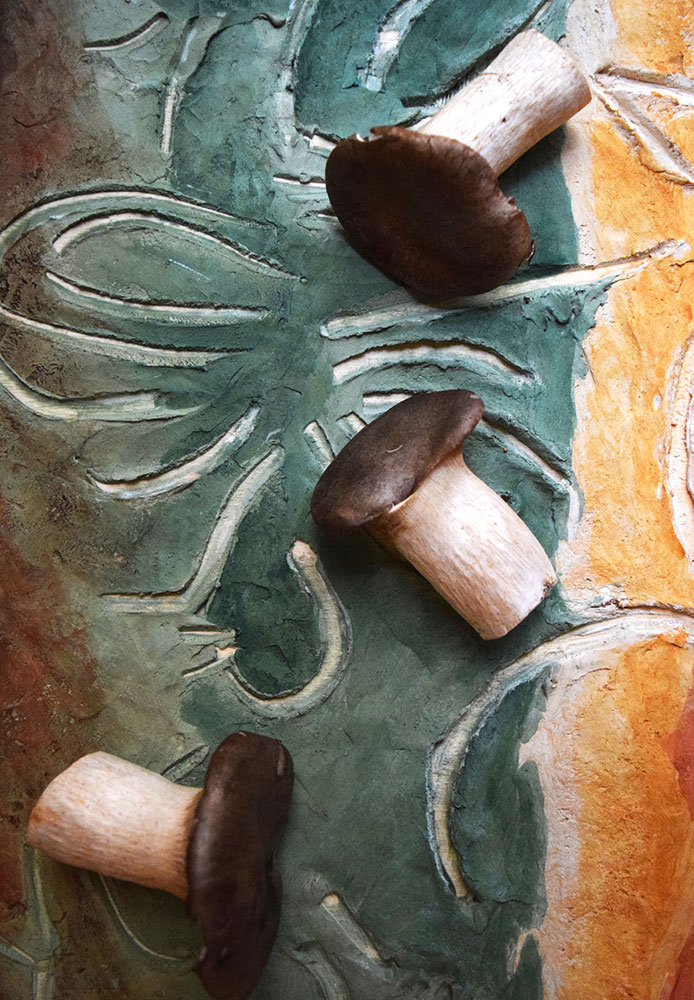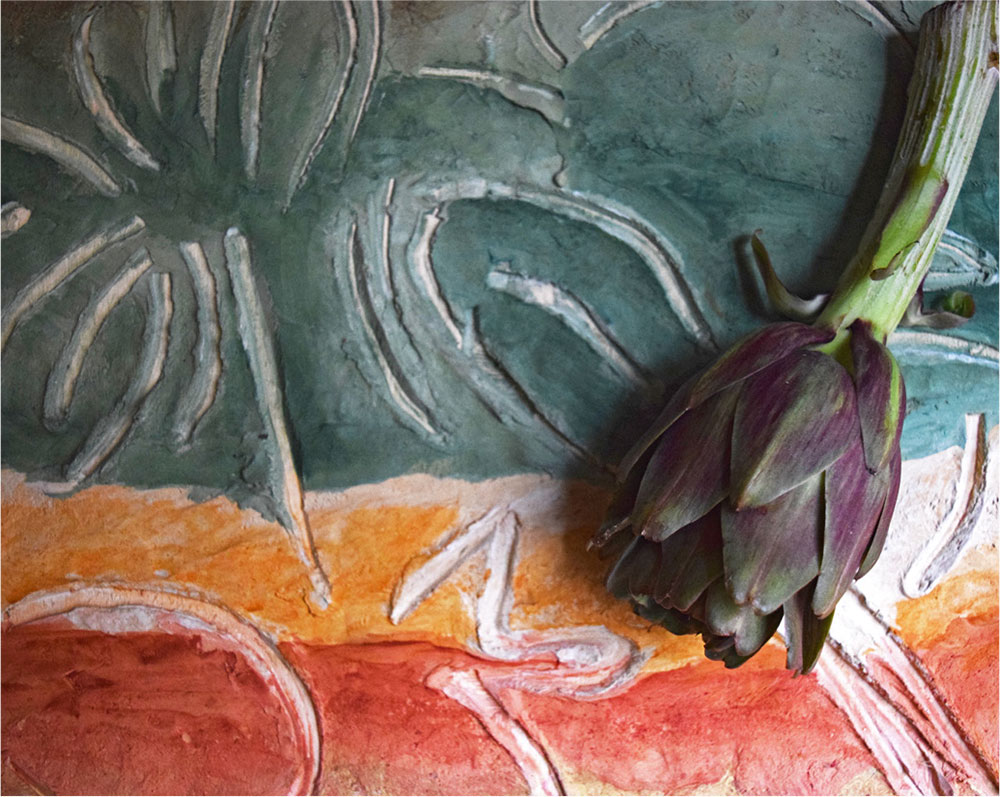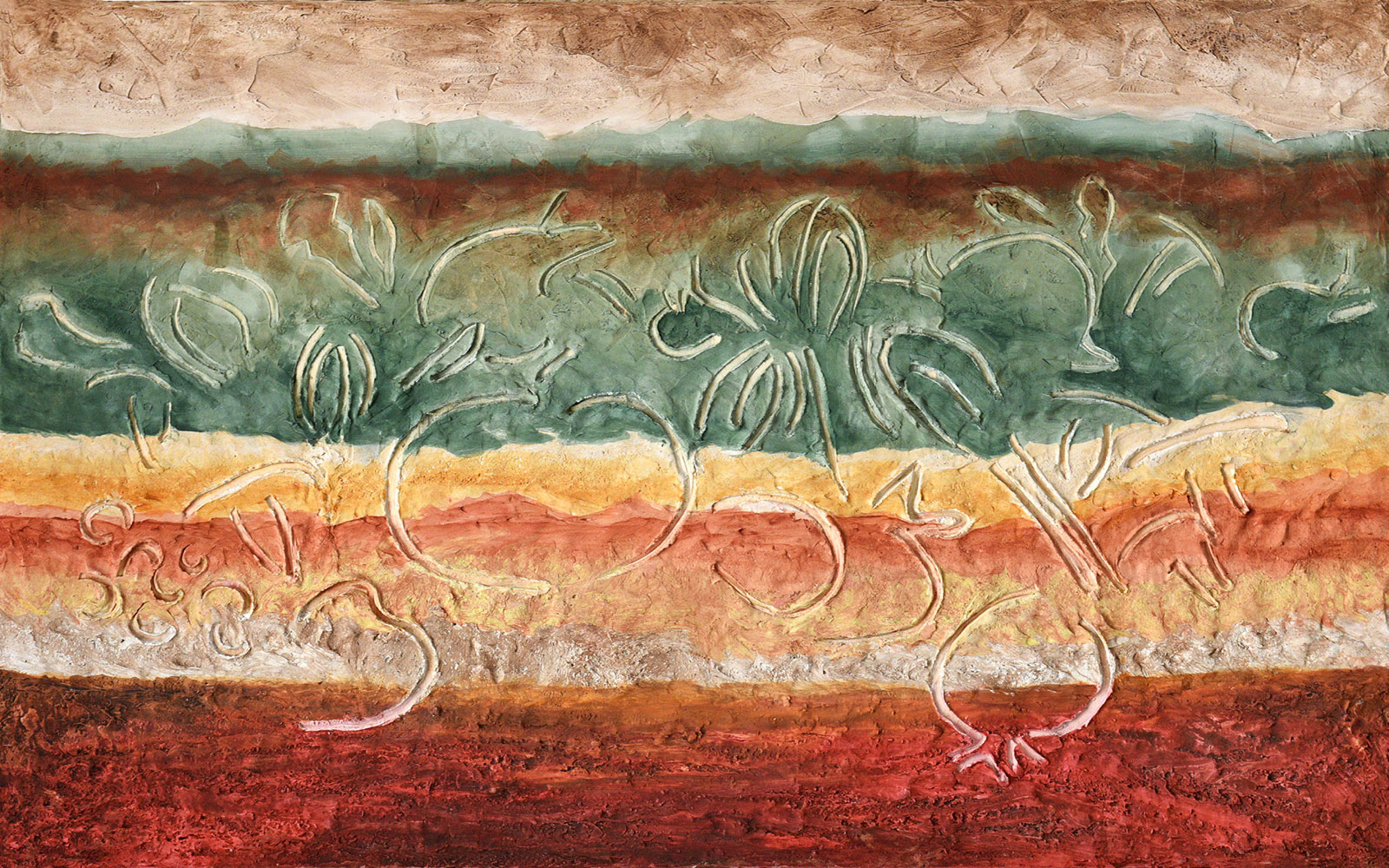AU-
TUMN
The autumn menu is dressed in the color of the earth. Freed from the dry vegetation of summer, the Murgian land begins to sprout again and the wild herbs appear with the first humidity.

But the protagonist of the Murgia Appulo-Lucana, in this period, is the Cardoncello mushroom. The Murgia plateau is the cradle of this variety. In stony soils, mixed with grass, the mushroom finds its ideal habitat growing on the host plant, the Eryngium campestre and maritimum. The Pleurotus Eryngii, called Cardoncello, in addition to being an excellent source of minerals (phosphorus, potassium, selenium, magnesium, B vitamins) contains essential amino acids (lysine and tryptophan).
A mushroom that combines the qualities already described with versatility in the kitchen. Its consistency remains unchanged even after cooking. It can be eaten raw, roasted, fried, au gratin, sautéed and as a condiment in many dishes based on pasta, rice, meat, legumes and vegetables, maintaining its organoleptic qualities unchanged.
In the Donnapaola area, the Chanterelle or Finferlo – Cantarillus cibarius – is also very common, with a sweet and very fragrant taste. Also rich in the typical properties of mushrooms, it expands the offer of autumn flavours.
But if the Cardoncelli and Chanterelle mushrooms with their colour blend in with the dry leaves of Oak and Ferula, the shades of the autumn table change from green to red, passing through orange.

You can enjoy preparations with seasonal vegetables, such as: artichoke, cabbage, pumpkin, and others that although present all year round, in this season are richer in nutritional properties such as beetroot.
The color palette is completed with the colors of the typical fruit of this period:
Persimmons, Pomegranate, Grapes and Quince. Autumn vegetables and fruits have significant anti-aging properties.
From the earth, a great help comes to us with spontaneous plants such as Wild Carrot – Daucus carota – Hawthorn – Crateugus monogina – with red berries for infusions and jams, Dandelion – Taraxacum officinale – with October flowering, after the spring one. Dandelion with great purifying properties, is an edible plant in all its parts, roots, leaves and flower and is considered a true pharmacy of the woods, rich in proteins, carbohydrates, mineral salts and vitamins. It is a cholagogue, that is, it is able to stimulate the secretion of bile, allowing the correct functioning of the liver, as well as being a diuretic, depurative and tonic for the stomach. Its leaves have a high content of vitamin A and beta-carotene.
The properties of this plant and of all those wild herbs sometimes considered weeds, make us understand the generosity and gratuitousness of a land always ready to support man.
TRADITIONAL DISHES

SIDE DISHES
In the season when mushrooms reign supreme, first courses and side dishes with this precious gift from the earth cannot be missed. Cardoncelli and Chanterelle mushrooms with tomato are an excellent condiment for fresh pasta. Gratinated, baked and sautéed, as a tasty side dish for typical meat dishes. An important dish of the peasant tradition is the wild chicory with broad beans, where the drizzle of extra virgin olive oil is more than a condiment, it is a fundamental ingredient to enhance the bitter taste of the chicory and the sweetness of the broad bean puree. Few things and good, this is the secret of all time and the peasants know it well.
Broad beans and wild chicory
A simple and healthy dish par excellence. Dried and shelled broad beans are cooked until they become a soft puree. Separately, wild chicory is boiled – alternatively cultivated chicory and sometimes mixed with chard – and everything is served on the same plate, with extra virgin olive oil. It can be enjoyed with warmed stale bread croutons.
Stuffed artichokes and arraganet (gratin)
Freed from its outer leaves, the artichoke is widened in the center to make room for the filling made of wet bread, egg, cheese, parsley and the addition of the stem. Baked in the oven with diced potatoes. The au gratin version includes a seasoning of eggs and cheese.Baked Cardoncelli and Arraganet (Gratinated)
Place the mushrooms on the bottom of the pan, sprinkle with breadcrumbs made of toasted and grated stale bread mixed with garlic, parsley, salt – or in the variant with wild herbs such as thyme. Cooked in the oven, they release water and unleash their characteristic earthy scent. They are also excellent seasoned with just garlic, oil and a sprinkling of aged local cheese.Baked pumpkin
The pumpkin, cut into slices just over a centimeter thick, is baked in the oven with wild herbs and served with extra virgin olive oil.FIRST COURSES
Cavatelli with Cardoncelli mushrooms
The chopped mushrooms are cooked in a sauce of olive oil and garlic, then the chopped tomatoes are added. Once the cavatelli are heated, they are seasoned with the sauce and a sprinkling of aged local cheese.Spaghetti alla San Giuannin
Cook some garlic in a pan with extra virgin olive oil, a pinch of salt, tomato sauce, a handful of small capers and a couple of anchovies. Cook the sauce well and pour in the spaghetti just drained. Mix and serve hot.Segnalet’ (pasta squares) with beans or chickpeas
Prepare the pasta dough with semolina flour and eggs, cut out small squares and let them dry while cooking the legumes, beans or chickpeas as desired. Separately prepare a soffritto with oil, lard and breadcrumbs to pour hot on the legumes and pasta.Rice in a pan with potatoes and artichokes, or a variant with mussels
Layers of rice alternate with layers of artichokes and potatoes seasoned with olive oil, salt, onion and cherry tomatoes. Once the pan is filled, it will be cooked in the oven with the addition of water useful for cooking the rice. The seafood variant includes mussels instead of artichokes. In Puglia, in the land of Bari, this dish is known as Tiella Riso patate e cozze.Vermicelli with Finiferli
The vermicelli go well with the more elongated shape of this mushroom that is cooked with olive oil and garlic. At the end of cooking, add a few tomatoes and the vermicelli. Mix in the pan still on the heat and serve.SECOND COURSES
Carne du munacidd (monachicchio meat)
Pitted and chopped black olives, parsley, chili pepper, olive oil and salt, are mixed and placed on the bottom of a terracotta pan. With the flame on, place the slices of veal on the dressing, then cover with another layer of dressing and cook the meat. Serve hot.Baccalà a zipp (cod soup)
After soaking the cod pieces, they should be put in a pan where a broth of olive oil, sliced onion, tomato, salt and parsley has already been cooked. Cook everything for about fifteen minutes, remove from the heat, sprinkle with raisins and serve.Baked Sausage and Mushroom Pan
Arrange potato cubes seasoned with olive oil and salt on the bottom of the pan, then place the knife-point pork sausage and mushrooms. Season again with a little olive oil, salt and a sprinkling of aged local cheese. Add a drizzle of water and bake, preferably covered, to favor the level of humidity during cooking and preserve the aromas. Ten minutes before the end of cooking, cook without a lid. Serve hot.TROUSERS
Meat calzone
Same procedure for the leavened dough. The filling is made of minced veal, cherry tomatoes, olive oil, salt. Cook in a pan and add local aged cheese, grated inside the preparation, once cooked. Roll out the discs, fill and bake.Mozzarella and tomato calzone
Spread the leavened dough in an oiled pan, fill with mozzarella slices and tomato pieces. Season with olive oil, salt and basil. Close the calzone with the second disk and bake. The fried version is also called Panzerotto.Onion Calzone
Prepare the dough with durum wheat flour, water and yeast, let it rest for a couple of hours and in the meantime prepare the filling of onion cooked in a pan with a little water, olive oil and salt, until it reduces in volume. Add a few cherry tomatoes and finish cooking. With the heat off, add capers, anchovies and raisins. Roll out a disk of leavened dough in a well-oiled pan, fill with the filling, cover with a second disk, folding the edges and bake in the oven. The small-sized calzone can also be fried.Swiss chard calzone
A variation in the dough can be made with wholemeal flours that give a rustic level to the calzone. The freshly cooked chard is salted and seasoned with olive oil, grated mature local cheese. The filling can also be enriched with pieces of caciocavallo and bacon. Close the leavened dough discs and bake. The variations for the filling are endless, the most popular one in Puglia is with stewed turnip tops and chili pepper.SWEETS
Pink cake
The pink cake is made of chopped almonds, flour, sugar and eggs, baked in the oven, rises and takes on a pink color on the surface. Very tasty even after a few days, suitable for any time of the day.Soft pastries
A sweet made with flour, sugar, grapes, milk, yeast and a little grated lemon. Knead, shape into a round and bake.Sweet Panzerottini with Quince Jam
Sweet panzerottini are made of a slightly sweet shortcrust pastry, worked with white wine and baked in the oven. The jam filling can vary between quince compote, grapes or cherries.EDIBLE HERBACEOUS SPECIES OF THE APULIA FLORA PRESENT IN THE MURGIAN TERRITORY OF DONNAPAOLA
Biodiversity is one of the distinctive features of the donnapaola company. Its territory is rich in edible plants that have always accompanied the life of the populations of this land. Used for food and medicine, wild herbs represent a true heritage. Leaves, stems, roots and flowers, everything contributes to the recovery of good practices.
Below we offer you a list of plants used for the preparation of dishes.
| NOME SCIENTIFICO | NOME VOLGARE | FAMIGLIA | PARTE EDULE |
|---|---|---|---|
| Anagallis arvensis L. | Centocchio dei campi | Primulacea | Foglia |
| Asparagus acutifolius L. | Asparago pungente | Liliaceae | Stelo |
| Asphodeline lutea L. Rchb. | Asfodelo giallo | Liliaceae | Stelo radice |
| Bellis perennis L. | Pratolina comune | Asteraceaea | Foglia fiore |
| Calamintha nepeta (L.) Savi | Mentuccia comune | Lamiaceaea | Foglia |
| Cichorium intybus L. | Cicoria comune | Asteraceaea | Foglia |
| Clinopodium vulgare L. subsp. | Clinopodio dei boschi | Laminaceaea | Foglia |
| Echium vulgare L. | Viperina azzurra | Boraginaceae | Foglia |
| Ferula communis L. | Ferula comune | Apiaceae | Stelo |
| Foeniculum vulgare Mill. | Finocchio comune | Apiaceae | Stelo infiorecsenza |
| Malva sylvestris L. | Malva selvatica | Malvaceae | Fiore |
| Marrubium vulgare | Marrubio comune | Lamiaceae | Stelo foglia |
| Nigella damascena L. | Damigella scapigliata | Ranuncolaceae | Foglia |
| Onobrychis caput-galli (L.) Lam. | Lupinella cresta di gallo | Fabaceae | Baccello fresco |
| Ornithogalum umbellatum L. | Latte di gallina comune | Liliaceae | Bulbo |
| Picris hieracioides L. | Asparagina comune | Asteraceae | Foglia |
| Portulaca oleracea L. subsp. | Porcellana comune | Portulacaceae | Foglia stelo |
| Reichardia picroides (L.) Roth | Grattalingua | Asteraceae | Foglia |
| Rubus ulmifolius Schott | Rovo comune | Rosaceae | Frutto seme |
| Salvia verbenaca L. | Salvia minore | Lamiaceae | Foglia |
| Sanguisorba minor Scop. | Salvastrella minore | Rosaceae | Foglia |
| Scolymus hispanicus L. subsp. | Cardogna comune | Asteraceae | Radice foglia |
| Scorpiurus muricatus L. | Erba lombrica comune | Fabaceae | Baccello fresco |
| Sedum rupestre L. subsp. | Borracina rupestre | Crassulacea | Stelo foglia |
| Sonchus oleraceus L. | Grespino comune | Asteraceae | Foglia |
| Tordylium apulum L. | Ombrellini Pugliesi | Apiaceae | Seme foglie |
| Tragopogon porrifolius L. | Barba di becco violetta | Asteraceae | Radice foglia stelo |
| Tribulus terrestris L. | Tribolo comune | Zigophylitaceae | Foglia stelo |
| Urospermum dalechampii (L.) | Boccione maggiore | Asteracea | Foglia |
| Vicia villosa Roth | Veccia pelosa | Fabaceae | Foglia stelo |
| Salvia verbenaca L. | Salvia minore | Lamiaceae | Foglia |
| Sanguisorba minor Scop. | Salvastrella minore | Rosaceae | Foglia |
| Scolymus hispanicus L. subsp. | Cardogna comune | Asteraceae | Radice foglia |



